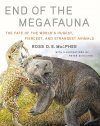![Twilight of the Mammoths Twilight of the Mammoths]()
Click to have a closer look
About this book
Contents
Customer reviews
Biography
Related titles
Recommended titles
About this book
As recently as 11,000 years ago – "near time" to geologists – mammoths, mastodons, gomphotheres, ground sloths, giant armadillos, native camels and horses, the dire wolf, and many other large mammals roamed North America. In what has become one of science's greatest riddles, these large animals vanished in North and South America around the time humans arrived at the end of the last great ice age. Part paleontological adventure and part memoir, Twilight of the Mammoths presents in detail internationally renowned paleoecologist Paul Martin's widely discussed and debated "overkill" hypothesis to explain these mysterious megafauna extinctions. Taking us from Rampart Cave in the Grand Canyon, where he finds himself "chest deep in sloth dung," to other important fossil sites in Arizona and Chile, Martin's engaging book, written for a wide audience, uncovers our rich evolutionary legacy and shows why he has come to believe that the earliest Americans literally hunted these animals to death.
As he discusses the discoveries that brought him to this hypothesis, Martin relates many colorful stories and gives a rich overview of the field of paleontology as well as his own fascinating career. He explores the ramifications of the overkill hypothesis for similar extinctions worldwide and examines other explanations for the extinctions, including climate change. Martin's visionary thinking about our missing megafauna offers inspiration and a challenge for today's conservation efforts as he speculates on what we might do to remedy this situation – both in our thinking about what is "natural" and in the natural world itself.
Contents
List of Illustrations
Acknowledgments
Prologue
1 Discovering the Last Lost World
Radiocarbon Dating and Quaternary Extinctions
2 Overview of Overkill
3 Ground Sloth Dung and Packrat Middens
Giant Meat-Eating Bats?
4 Ground Sloths at Home
Cryptozoology, Ground Sloths, and Mapinguari National Park
5 Grand Canyon Suite: Mountain Goats, Condors, Equids, and Mammoths
6 Deadly Syncopation
7 Digging for the First People in America: High Stakes at Tule Springs
Tricks, Hoaxes, and Bad Science
8 Kill Sites, Sacred Sites
9 Models in Collision: Climatic Change versus Overkill
10 Restoration
Unexpected Ramifications of Ecological Change
11 Resurrection: The Past Is Future
Epilogue
References
Index
Customer Reviews
Biography
Paul S. Martin is Emeritus Professor of Geosciences, Desert Laboratory, University of Arizona.
By: Paul S Martin(Author), Harry W Greene(Foreword By)
250 pages, 17 b/w photos, 12 b/w illustrations
"The book is a terrific description of science at work, and functions as a primer on the nature of research – the collecting of data, the examination of competing hypotheses, the responses to criticisms."
– Jon Shumaker, Tucson Weekly
"Balancing scientific data with scintillating tales of archaeological adventures, Martin presents a sometimes cautionary tale in which he urges the celebration of these extinct marvels as a way of not only appreciating the vast biotic wealth of our planet but also as a means of inspiring today's conservation efforts."
– Booklist
"A cogent, impassioned case that has the potential to reshape conservation biology practices [...] An engaging tale of scientific discovery that uncovers a lost part of the planet's wild, evolutionary legacy and offers some very bold ideas on how to reclaim it."
– Keith Kloor, Audubon Magazine
"Martin delivers an energetic and highly entertaining look at one of the most controversial issues in his field [...] [He] uses his own extensive research – as well as amusing insights from his personal life and career – to make his case."
– Publishers Weekly
"Twilight of the Mammoths is well written and can be easily understood by nonscientists [...] Natural history enthusiasts will certainly enjoy this book."
– American Scientist
"Martin is a national treasure, one of the last great minds from a time when biology was about understanding the world and our place in it, rather than the get-rich quick scheme of biotechnology that it's become. This book is a testimony to his brilliance."
– Tucson Weekly
"Martin's prose is folksy and engaging. It is a treat to learn the personal and historical story behind his studies of overkill [...] [He] has made a career of challenging orthodoxy and in the process has revolutionized the way we understand our history as a species and the world that we have shaped."
– Science (AAAS)
"Paul S. Martin's innovative ideas on late quaternary extinctions and wildlife restoration have fueled one of science's most stimulating recent debates. He expounds them vividly here, and defends them eloquently. A must-read."
– David Rains Wallace, author of Beasts of Eden
"This is a marvelous read, by a giant in American prehistory, about one of the greatest mysteries in the earth sciences."
– Tim Flannery, author of The Eternal Frontier
"Whether or not you agree with Paul Martin, he has shaped how we think about our Pleistocene ancestors and their role in transforming this planet."
– Ross D. E. MacPhee, Curator of Mammalogy, American Museum of Natural History










































